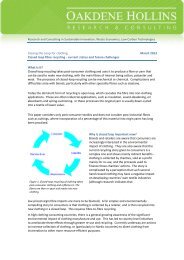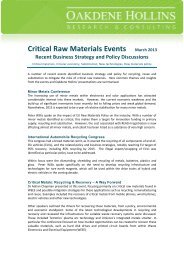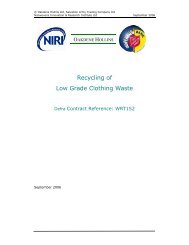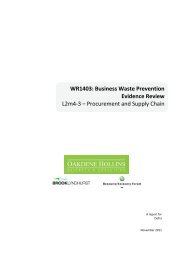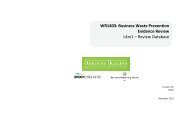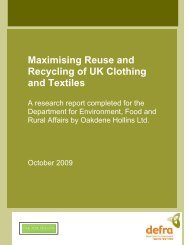Fire Retardant Technologies: safe products with ... - Oakdene Hollins
Fire Retardant Technologies: safe products with ... - Oakdene Hollins
Fire Retardant Technologies: safe products with ... - Oakdene Hollins
- No tags were found...
Create successful ePaper yourself
Turn your PDF publications into a flip-book with our unique Google optimized e-Paper software.
mattresses,fillings for bedmattresses2013 certain R-Phrases. Alternative hazardstatements are used.As discussed in Annex 4, the current EU Ecolabel contains exclusions for “additive” FRs inclothing and textiles where only reactive flame retardants are allowed plus restriction oncertain risk phrases – these are summarised in Appendix B.In electronic equipment, polybrominated biphenyls and polybrominated dipehnylethers andlow to medium molecular weight chloroparaffins are excluded. In mattresses only reactiveFRs are allowed and there are restrictions based on certain risk phrases.Some of the issues concerned <strong>with</strong> current ecolabel criteria are:1. Are approaches based on the use of risk phrases the most effective way to assessenvironmental performance.2. Is it appropriate to exclude chemical FRs on the basis that they are “additive” ratherthan “reactive”.3. Should “reactive” FRs be viewed as inherently lower hazard and risk than additiveFRs.4. Would it be appropriate to consider the exclusion of chemical classes of FR such asthe organohalogen compounds combined <strong>with</strong> specific exemptions.Green ProcurementIn 2005 the European Commission published a communication outlining the need for EUMember States to implement National Action Plans (NAP) for developing Green PublicProcurement (GPP). These NAPs are non-legally binding but do allow Member States toraise awareness of greener procurement of sustainable <strong>products</strong>.The EU has developed GPP guidelines for the benefit of purchasing officials and companieswishing to tender for contracts. Of the 10 product groups that have been established, officeIT equipment and textiles <strong>products</strong> are relevant to the current study and include statementsregarding fire retardants. In all cases if the product has obtained the EU Ecolabel then it willautomatically comply <strong>with</strong> the procurement policy. Other so-called Type 1 Ecolabels are alsoacceptable. So it is inevitable that the application of GPP is likely to use Ecolabel criteria andthe two should be viewed as linked.Any criteria that form the basis for Ecolabel awards or which support Green PublicProcurement would be advised to align their criteria on chemical <strong>safe</strong>ty <strong>with</strong> that of the newCLP definitions of risk phrases and hazard statements. Consideration should also be givenon the handling of chemical bans <strong>with</strong>in the decisions taken under the operation of REACHin the future. However some care is required in handling policy situations that may developover the next 2 to 5 years as REACH becomes established.Chemical Risk Assessment and ClassificationEuropean chemical risk phrases are used in EU Ecolabel criteria for FRs. These wereoriginally defined in Council Directive 67/548/EEC of 27 June 1967 on provisions relating toP a g e 12 |




